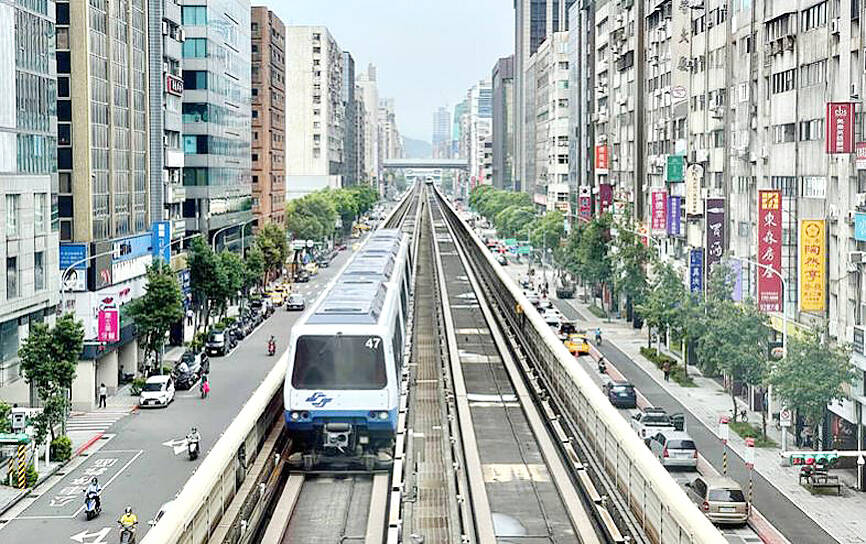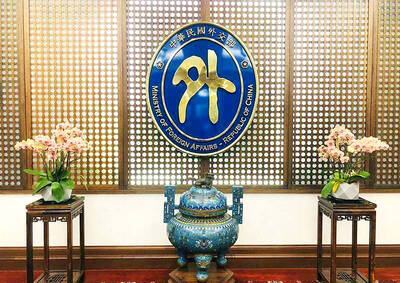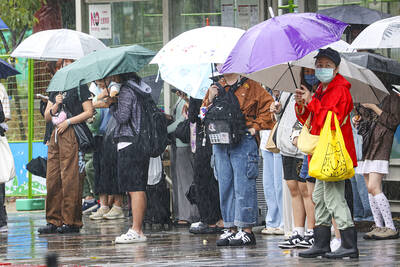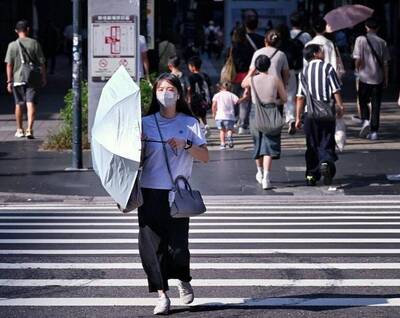Taipei Rapid Transit Corp (TRTC) had a more than NT$1.5 billion (US$47.79 million) deficit from its core operations last year, despite Taipei MRT ridership recovering to pre-COVID-19 levels.
A National Audit Office report on Taipei’s financial statements from last year showed that the company only profited from two MRT lines.
Daily ridership last month was about 1.83 million.

Photo: George Tsorng, Taipei Times
The Bannan Line (Blue Line, 板南線) turned a profit of about NT$1.13 billion and the Tamsui-Xinyi Line (Red Line, 淡水信義線) had a profit of about NT$328.4 million, while the Wenhu Line (Brown Line, 文湖線) had the highest deficit of nearly NT$1.23 billion.
The Taipei MRT system launched with the Wenhu Line in March 1996, expanding to five lines — the Wenhu, Tamsui-Xinyi, Songshan-Xindian (Green Line, 松山新店線), the Zhonghe-Xinlu (Orange Line, 中和新蘆線) and Bannan lines.
Only the Wenhu Line is a medium-capacity rail system, while the others are heavy rail rapid transit systems.
TRTC operating income and expenditure data from 2018 to last year show that the total deficit from its transportation operation increased from about NT$1.356 billion in 2018 to about NT$1.574 billion last year.
While the Bannan and Tamsui-Xinyi lines were profitable last year, they made 21.7 percent and 60.71 percent less than in 2018 respectively — about NT$1.45 billion and NT$771 million.
The other three lines had operating deficits every year.
Last year, the Wenhu Line had a deficit of about NT$1.23 billion, the Zhonghe-Xinlu Line was in the red about NT$1.15 billion and the Songshan-Xindian Line had a deficit of about NT$625 million. Those figures were smaller than their reported deficits in 2018: about NT$1.49 billion, NT$1.37 billion and NT$771 million respectively.
The National Audit Office’s report said that passenger volume on the Wenhu Line fell 32.94 percent, the Bannan Line fell 31.12 percent and the Tamsui-Xinyi Line fell 24.53 percent.
However, it said that TRTC failed to review the drops in ridership, so it asked the company to investigate and make improvements.
TRTC said it would continue to study cost-saving measures for each of its lines to reduce operating deficits, and that it would analyze the lines and come up with plans for each line to increase ridership.
Separately, an audit office report on Taoyuan’s financial statements showed that Taoyuan Metro Corp had a net loss of about NT$861 million last year, due to the pandemic.
Along with a deficit of about NT$2.84 billion from the previous year, the company would need to recover from a deficit of more than NT$3.75 billion, the report said.
The company used up its working capital of NT$3 billion in the first part of last year, and was operating on a bank loan, with a final short-term debt of NT$873 million, it said, adding that Taoyuan Metro should continue to increase income and reduce expenditure in the post-pandemic era to speed up its debt repayment schedule.
The National Audit Office’s report on Taichung showed that the annual passenger volume of the Taichung MRT system increased to about 930,000 last year.
Taichung Mass Rapid Transit Corp posted a net loss of about NT$591 million last year, accumulating a total deficit of more than NT$2.08 billion, or about 69.56 percent of its capital amount, it said.

Temperatures in northern Taiwan are forecast to reach as high as 30°C today, as an ongoing northeasterly seasonal wind system weakens, the Central Weather Administration (CWA) said. CWA forecaster Tseng Chao-cheng (曾昭誠) said yesterday that with the seasonal wind system weakening, warmer easterly winds would boost the temperature today. Daytime temperatures in northern Taiwan and Yilan County are expected to range from 28°C to 30°C today, up about 3°C from yesterday, Tseng said. According to the CWA, temperature highs in central and southern Taiwan could stay stable. However, the weather is expected to turn cooler starting tonight as the northeasterly wind system strengthens again

The Ministry of Foreign Affairs (MOFA) yesterday expressed “grave concerns” after Singaporean Prime Minister Lawrence Wong (黃循財) reiterated the city-state’s opposition to “Taiwanese independence” during a meeting with Chinese Premier Li Qiang (李強). In Singapore on Saturday, Wong and Li discussed cross-strait developments, the Singaporean Ministry of Foreign Affairs said in a statement. “Prime Minister Wong reiterated that Singapore has a clear and consistent ‘one China’ policy and is opposed to Taiwan independence,” it said. MOFA responded that it is an objective fact and a common understanding shared by many that the Republic of China (ROC) is an independent, sovereign nation, with world-leading

COOLING OFF: Temperatures are expected to fall to lows of about 20°C on Sunday and possibly 18°C to 19°C next week, following a wave of northeasterly winds on Friday The Central Weather Administration (CWA) on Sunday forecast more rain and cooler temperatures for northern Taiwan this week, with the mercury dropping to lows of 18°C, as another wave of northeasterly winds sweeps across the country. The current northeasterly winds would continue to affect Taiwan through today, with precipitation peaking today, bringing increased rainfall to windward areas, CWA forecaster Liu Pei-teng (劉沛滕) said. The weather system would weaken slightly tomorrow before another, stronger wave arrives on Friday, lasting into next week, Liu said. From yesterday to today, northern Taiwan can expect cool, wet weather, with lows of 22°C to 23°C in most areas,

Taiwan sweltered through its hottest October on record, the Central Weather Administration (CWA) said yesterday, the latest in a string of global temperature records. The main island endured its highest average temperature since 1950, CWA forecaster Liu Pei-teng said. Temperatures the world over have soared in recent years as human-induced climate change contributes to ever more erratic weather patterns. Taiwan’s average temperature was 27.381°C as of Thursday, Liu said. Liu said the average could slip 0.1°C by the end of yesterday, but it would still be higher than the previous record of 27.009°C in 2016. "The temperature only started lowering around Oct. 18 or 19